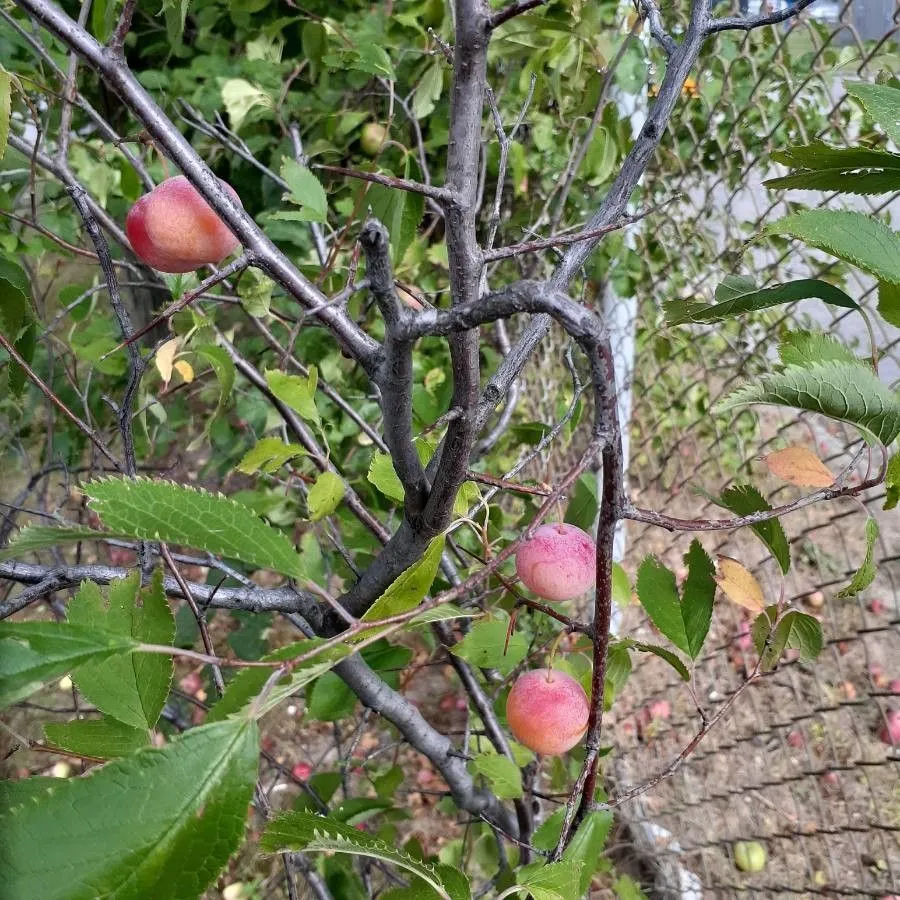
Author: Marshall
Bibliography: Arbust. Amer.: 111 (1785)
Year: 1785
Status: accepted
Rank: species
Genus: Prunus
Vegetable: False
Observations: C. & E. Canada to U.S.A.
Goose plum, scientifically known as Prunus americana, is a deciduous shrub or small tree native to North America, encompassing regions from Central and Eastern Canada down to the United States. It thrives particularly well in various habitats, demonstrating a great deal of adaptability to different environmental conditions.
Belonging to the Rosaceae family, which includes a wide array of fruit-bearing plants, the goose plum stands out for its ornamental value as well as its edible fruits. This species was first described by Marshall in 1785, as detailed in the publication “Arbust. Amer.: 111.”
The plant typically reaches heights of 4 to 10 meters, with a spread that can vary considerably depending on the growing conditions. Its leaves are simple, alternate, and oval-shaped with serrated edges, imparting a lush green hue that turns vividly colorful in the fall, adding to its appeal as a landscape plant.
In spring, Prunus americana produces clusters of fragrant, white flowers, each boasting five petals. These blossoms are not only attractive but also play a crucial role in the ecosystem by providing nectar for pollinators such as bees and butterflies. Following the flowering period, the plant bears small, round, drupaceous fruits. They are initially green but ripen to a striking yellow, red, or purplish hue by late summer.
The fruits of the goose plum are edible and often used in jellies, jams, and preserves. While they can be somewhat tart when raw, their flavor becomes wonderfully sweet when cooked. These plums are also a source of food for wildlife, providing sustenance for birds and small mammals.
In terms of cultivation, goose plum is relatively low-maintenance. It prefers well-drained soils and can tolerate a range of soil types from sandy to loamy. It does best in full sun to partial shade. However, for optimal fruit production, full sun exposure is recommended. The plant is also quite hardy, withstanding cold temperatures and drought conditions once established.
Apart from its practical uses, the goose plum holds cultural significance among various indigenous communities, who have utilized the plant for both its nutritional and medicinal properties.
In conclusion, Prunus americana, or the goose plum, is a versatile and valuable plant species with a wide array of uses and environmental benefits, making it a beloved and integral part of North American flora.
Eng: american plum, american red plum, goose plum, american wild plum, wild plum, wild red plum, wild yellow plum
Deu: amerikapflaume, amerikanische pflaume
Por: ameixeira-americana
Swe: amerikanskt plommon
Spa: ciruelo americano
Fra: prunier américain, prunier d’amérique
En: Goose plum, American plum, American red plum, Ma’xemenó’e, American wild plum, Wild plum, Wild red plum, Wild yellow plum
Ar: خوخ أمريكي
Az: Amerika gavalısı
Zh: 美洲李
Fi: Amerikanluumu
Fr: Prunier américain, Prunier d’Amérique
De: Amerikapflaume, Amerikanische Pflaume, Amerikanische Wildpflaume
He: שזיף אמריקאי
Fa: پرونوس آمریکایی
Pl: Śliwa amerykańska
Pt: Ameixeira-americana
Es: Ciruelo americano
Sv: Amerikanskt plommon
Taken Aug 20, 2022 by T H (cc-by-sa)
Taken Oct 13, 2022 by kora leach (cc-by-sa)
Taken Jul 23, 2022 by Krystal Dittmer (cc-by-sa)
Taken Sep 11, 2022 by Vance Martin (cc-by-sa)
Taken Aug 30, 2021 by Arthur Ordona (cc-by-sa)
Taken Jan 7, 2022 by Taylor Shook (cc-by-sa)
Taken Jan 7, 2022 by Taylor Shook (cc-by-sa)
Taken Jan 7, 2022 by Taylor Shook (cc-by-sa)
Taken Oct 13, 2022 by kora leach (cc-by-sa)
Taken Oct 13, 2022 by kora leach (cc-by-sa)
© copyright of the Board of Trustees of the Royal Botanic Gardens, Kew.
© copyright of the Board of Trustees of the Royal Botanic Gardens, Kew.
Growth form>: Single Stem
Growth habit>: Tree, Shrub
Growth rate>: Moderate
Ph maximum: 7.0
Ph minimum: 5.0
Family: Myrtaceae Author: (F.Muell.) K.D.Hill & L.A.S.Johnson Bibliography: Telopea 6: 402 (1995) Year: 1995 Status:…
Family: Rubiaceae Author: Pierre ex A.Froehner Bibliography: Notizbl. Bot. Gart. Berlin-Dahlem 1: 237 (1897) Year:…
Family: Sapindaceae Author: Koidz. Bibliography: J. Coll. Sci. Imp. Univ. Tokyo 32(1): 38 (1911) Year:…
Family: Asteraceae Author: A.Gray Bibliography: Pacif. Railr. Rep.: 107 (1857) Year: 1857 Status: accepted Rank:…
Family: Fabaceae Author: Medik. Bibliography: Vorles. Churpfälz. Phys.-Ökon. Ges. 2: 398 (1787) Year: 1787 Status:…
Family: Aspleniaceae Author: (Cav.) Alston Bibliography: Bull. Misc. Inform. Kew 1932: 309 (1932) Year: 1932…